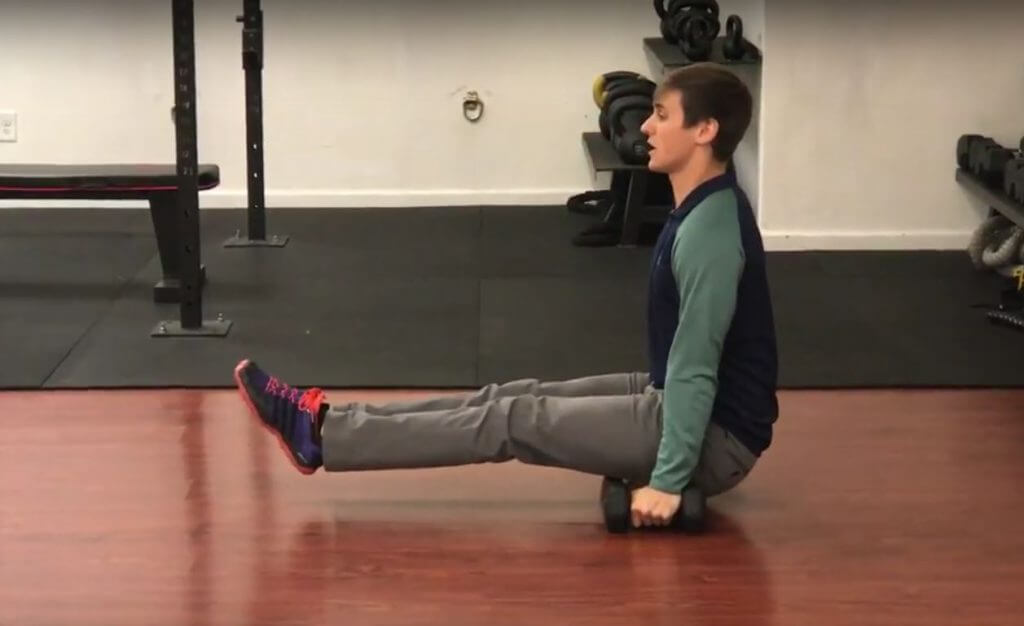L-Sit: The Toughest Body Weight Core Exercise You’re Not Doing

By Dr. G. John Mullen, Swimming World Contributor.
We have all heard the core is essential for swimming. Some debate the amount of necessary core work for elite swimming performance. Others argue the lack of specificity of traditional core exercises with swimming.
No matter your belief, everyone in the swimming community feels the core is essential for swimming.
Many swim teams fall into these traps, which I discussed in a previous article:
- One Plane, one contraction: If you are not familiar with the planes of motion or different types of muscular contraction, check out Swimming Science’s Glossary page. Too often swim teams only strengthen the front of their core. Think about it: planks, sit-ups, leg lifts, flutter kicks, etc. These are the exercises many swimmers do for hours, but the core is a diverse group of muscles (see above) and for our sport, strength in every plane of motion is mandatory. On top of this, some teams only do planks, hoping on the anti-flexion movement. While not flexing the spine can reduce volume, the core must safely flex the spine, as well as stabilize the body as the arms and legs create force.
- Too much volume: Although storied athletes have done millions of sit-ups with much success, we can’t confuse correlation with causation. Often, excessive volume results in overuse and improper form, which is a waste of time and risk of injury. Instead, lowering the volume and trying to maximize a core contraction creates more power, while being safer. As in swimming, the core shouldn’t be trained for just endurance! Mix up the intensity and provide core training of varying volume. Many teams neglect low-volume, high-intensity core training, which neglects our type II muscle fiber development.
- Poor integration: The core muscles contract during every motion. Simply raising the arm overhead contracts the core, yet few think about developing strength for the core. During dryland, simply think about the core contraction and creating a stable core during strength training for enhanced core training. As stated, isolated training isn’t the answer (as least for everyone), so work on strengthening the core during full-body movements.
The L-sit does fall into a few of these traps, it still works on the anterior sagittal plane of strengthening (think the front of your core). However, if done with the correct progression it will be more challenging (preventing excessive volume) and integrate the triceps and shoulders. Outside of strength it also requires a straight spine and pointed toes, both essential components for swimming performance.
Keys to Proper L-Sit Positioning
Proper form during the L-sit is key, as poor form with increase your risk of injury and body stress. As a swimmer, great stress is already placed on the body, we don’t want to add any more stress during the exercise!
Every body part has an important part during the L-sit, but here are the main points.
- Head – Chin tucked, eyes forward.
- Chest – Big, broad chest.
- Shoulders – Pull down, shoulders back.
- Elbows – Straight and strong.
- Back – Straight as an arrow.
- Knees – Straight and locked.
- Toes – Pointed down.
Where to do L-Sits?
If you have ever seen the L-sit, you’ve likely seen it performed on different surfaces. The most common apparatuses are the floor, rings, or parallettes/dumbbells. For swimmers, I highly suggest using parallettes or dumbbells to keep your wrist in a straight and safe position. If you master the L-sit, progressing to rings is a viable, but challenging option. I only suggest doing this if you are advanced and have progressed safely through the L-sit progression.
L-Sit Progression
1. Feet on Ground: Push your hands down, keep your shoulders down (don’t wear them as earrings), but have your heels still on the ground. Keep your butt directly under your shoulders.
2. Alternating Feet: Get in the above position, alternate raising one leg off the ground, then switch.
3. Tuck Position: After mastering the alternating feet, attempt to have both feet off the ground and have the start having the knees bend and hold them to the chest.
4. Full Alternating Leg Extension: Work on fully extending one leg at a time, attempt to hold the leg straight for 5 seconds.
5. Full L-Sit: You made it! Now extend those knees and hold on tight!
L-Sit Training
If looking to master the L-sit, like anything else, you need to practice it! I suggest practicing this maneuver three times per week, at every dryland.
- Begin at the easiest progression above and progress to the level you are unable to perform. At each level perform 3 sets of 5 seconds.
- Once you determine the hardest level for yourself, do 3 sets of 5 seconds.
- Each week add a set until you can do 5 sets of the hardest exercise.
- Once you can do 5 sets of 5 seconds at the variation, progress to the next level.
Working through the L-Sit in this manner will help you gain the strength and control for a perfect L-Sit.
For more tips, check out the COR Swimmer’s Shoulder System! For other tips on improving your swimming, check this out.
All commentaries are the opinion of the author and do not necessarily reflect the views of Swimming World Magazine nor its staff. All swimming and dryland training and instruction should be performed under the supervision of a qualified coach or instructor, and in circumstances that ensure the safety of participants.




Kelsey Wilson
Anthony Clason
Drew Ross-Ashby
Actually, I really do not know about this exercise. It makes me curious more right now.